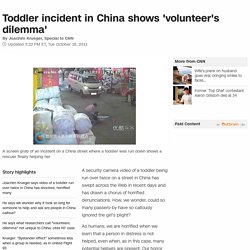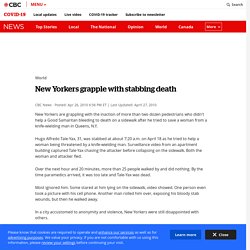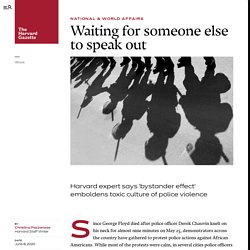

Bystander effect. Bystander effect, the inhibiting influence of the presence of others on a person’s willingness to help someone in need.

Research has shown that, even in an emergency, a bystander is less likely to extend help when he or she is in the real or imagined presence of others than when he or she is alone. Moreover, the number of others is important, such that more bystanders leads to less assistance, although the impact of each additional bystander has a diminishing impact on helping. Indifference Kills: Bystander Apathy. What Is the Bystander Effect? Why This One Effect Prevents You From Helping People In Need. THE BYSTANDER EFFECT. THE BYSTANDER EFFECT. Teens Harass And Humiliate the Homeless.
Teen boy physically and verbally abuses his girlfriend. Bystander Effect - people watch girl being abducted. An avoidable murder of a student caught on tape: the sickening power of the bystander effect. On Sept. 17, the life of a 16-year-old high schooler in Long Island ended tragically in a violent brawl outside a strip mall.

Khaseen Morris was told to show up outside the mall at a certain time by several others his age, after he was seen walking home the girlfriend of another boy. Morris showed up and was immediately attacked by a group of five teenagers. A senseless brawl erupted and Morris was stabbed repeatedly in the chest, dying later that night in the hospital. The tragedy of Morris’s murder extends beyond the senselessness of his violent death and the fact that an innocent young life ended so abruptly over a trivial adolescent dispute. The horrific nature of Morris’s murder is amplified by the fact that the brawl occurred in broad daylight and was filmed by a group of 50 teenagers, so that Morris’s stabbing was caught on dozens of phone cameras. It is deeply disturbing that the impulse to document Morris’s death far outweighed any instinct to help him. Remembering Kitty Genovese. In death, Kitty Genovese has cast a long shadow over America’s psyche, far more than she probably would have had her life not been brutally cut short at age 28.
Across the decades since her murder in 1964, she has endured as a symbol of urban disconnection and apathy, a victim not only of a knife-wielding killer but of bystanders’ unwillingness to get involved in resisting evil. The New York Times had a pivotal role in creating what is referred to as “Kitty Genovese syndrome.” A front-page article in March 1964 described how 38 of her neighbors heard her screams and watched, yet did nothing, while she was twice attacked and stabbed repeatedly on her way home from her job as a bar manager in Queens. The facts, however, turned out to be quite different. Yes, some neighbors had ignored Ms.
This haunting case emerged anew last week with news that the killer, Winston Moseley, had died in prison at age 81 after more than half a century of confinement. Ms. Bystander inaction, like 7-Eleven assault, more likely with more witnesses, experts say - Chicago Tribune. Toddler incident in China shows 'volunteer's dilemma'. A security camera video of a toddler being run over twice on a street in China has swept across the Web in recent days and has drawn a chorus of horrified denunciations.

How, we wonder, could so many passers-by have so callously ignored the girl's plight? As humans, we are horrified when we learn that a person in distress is not helped, even when, as in this case, many potential helpers are present. Our horror increases if the person is victimized in a particularly vicious or careless way by fellow human beings. Our horror is further heightened when we learn that the victim is helpless and the kind of person who normally stimulates our instinct to aid and protect. Our spontaneous reaction is to say: "Had I been there, I would have helped; what is wrong with these people? " It is true that cultural differences exist in many aspects of human behavior, and many of these differences are not trivial. Since the original experiments, many studies have explored the bystander effect. New Yorkers grapple with stabbing death.
New Yorkers are grappling with the inaction of more than two dozen pedestrians who didn't help a Good Samaritan bleeding to death on a sidewalk after he tried to save a woman from a knife-wielding man in Queens, N.Y.

Hugo Alfredo Tale-Yax, 31, was stabbed at about 7:20 a.m. on April 18 as he tried to help a woman being threatened by a knife-wielding man. Surveillance video from an apartment building captured Tale-Yax chasing the attacker before collapsing on the sidewalk. Both the woman and attacker fled. Over the next hour and 20 minutes, more than 25 people walked by and did nothing. By the time paramedics arrived, it was too late and Tale-Yax was dead. Most ignored him. In a city accustomed to anonymity and violence, New Yorkers were still disappointed with others.
"It's man's inhumanity toward man," one man told the CBC's David Common. The Bystander Effect - No One Cares. Overcoming the Bystander Effect. Overcoming the Bystander Effect. Have you ever been a hero? Going about our daily routines, few of us have the opportunity to save a life or disrupt a crime in progress—fewer still take that opportunity when it presents itself. I once witnessed a car accident in which the guilty party leapt from his disabled vehicle and fled the scene. I quickly pulled over and dialed 911. Fortunately, another passerby stopped and apprehended the suspect. The culprit—who was clearly intoxicated—struggled to escape, but he was easily overpowered. Not only are acts of heroism unsurprisingly rare, reports about observers who, out of indifference or perplexity, fail to report criminal behavior or respond to emergencies with inaction are common.
Teaching bystanders to intervene. Bystander intervention for good. The Bystander Effect - You Can Break the Cycle. Active bystander. Researchers Found the ‘Bystander Effect’ in 5-Year-Olds. Police violence and the ‘bystander effect’ explained.
Since George Floyd died after police officer Derek Chauvin knelt on his neck for almost nine minutes on May 25, demonstrators across the country have gathered to protest police actions against African Americans.

While most of the protests were calm, in several cities police officers have used force against demonstrators and journalists under the justification of crowd control. The sight of officers in riot gear beating marchers, firing rubber bullets and chemical- or pepper-based irritants, and shoving activists has reignited questions about accepted practices in the nation’s law enforcement community. Francesca Gino, Tandon Family Professor of Business Administration at Harvard Business School, studies leadership, the psychology of decision-making, and organizational behavior.
She has written about how an organization can develop a culture that can turn harmful to its own people, to the success of its mission, and to its own reputation. China’s Bad Samaritan Crisis. China’s toxic norm of ignoring those in…